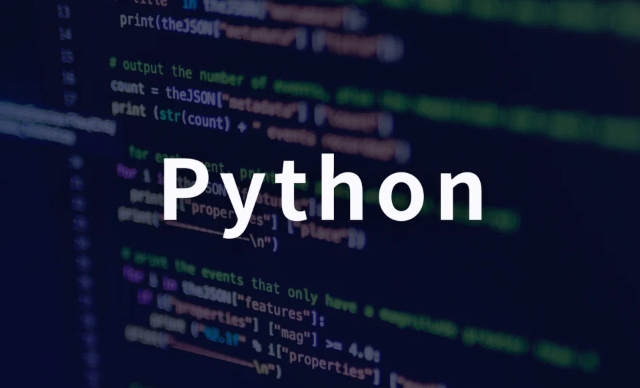asyncio.gather is used to execute multiple coroutines concurrently and return a list of results, which can significantly improve I/O-intensive tasks efficiency. 1. Use asyncio.gather(*coroutines) to run multiple coroutines concurrently, such as asynchronous HTTP requests, and return the results in order; 2. If a single task fails and does not affect the overall execution, you can set return_exceptions=True to make the exception return as a result instead of interrupting all tasks; 3. Applicable scenarios include batch API calls, parallel file reading, crawlers and microservice concurrent requests; 4. Note that coroutine objects (such as func()) must be passed in instead of function names, and coroutines with parameters can be generated through list derivation. Correct use of asyncio.gather can greatly improve program performance, especially suitable for scenarios where multiple independent asynchronous tasks are executed in parallel.

asyncio.gather is a very practical function in the Python asyncio module. It is used to run multiple coroutines concurrently, wait for them to complete, and finally return the result list. It can significantly improve the execution efficiency of I/O-intensive tasks.

Below is a clear and practical asyncio.gather example to help you quickly understand its usage.
? Basic usage example: Perform multiple asynchronous tasks concurrently
import asyncio
import aiohttp # Need to install first: pip install aiohttp
async def fetch_data(session, url):
print(f"Start request: {url}")
async with session.get(url) as response:
result = await response.text()
print(f"Complete request: {url}, content length: {len(result)}")
return len(result)
async def main():
urls = [
"https://httpbin.org/delay/1",
"https://httpbin.org/delay/2",
"https://httpbin.org/json"
]
async with aiohttp.ClientSession() as session:
# Use asyncio.gather to execute multiple requests concurrently results = await asyncio.gather(
*[fetch_data(session, url) for url in urls]
)
print("All results:", results)
# Run asyncio.run(main())? illustrate
-
asyncio.gather(*coroutines)receives multiple coroutine objects and executes them concurrently. - All tasks start at the same time, and
gatherwill wait for all to be completed. - The return value is a list in the order of the incoming coroutines.
- Implement asynchronous HTTP requests using
aiohttp(much faster thanrequests, especially when there are a large number of requests).
?? Error handling: How to avoid one failure causing all failures?
By default, if one of the coroutines throws an exception, gather will immediately break and throw an exception, and other tasks will be cancelled.

If you want to continue executing even if one task fails , you can use return_exceptions=True :
async def bad_request():
raise ValueError("Error!")
async def main_with_error_handling():
results = await asyncio.gather(
fetch_data(session, urls[0]),
bad_request(),
fetch_data(session, urls[1]),
return_exceptions=True # Errors will also be returned as a result, rather than thrown)
for i, result in enumerate(results):
if isinstance(result, Exception):
print(f"Task{i} failed: {result}")
else:
print(f"Task{i} Success: {result}")The output may be:

Task 0 Success: 1234 Task 1 Failed: An error occurred! Task 2 Success: 5678
? Applicable scenarios
- Bulk call API
- Read multiple files in parallel (asynchronous I/O)
- Crawler crawls multiple pages
- Microservice concurrent requests
?Things to note
-
asyncio.gatherpasses in a coroutine object , not function name. - Don't write it as
asyncio.gather(func), butasyncio.gather(func()). - If the coroutine function requires parameters, use a list comprehension to generate the coroutine object.
Basically that's it. asyncio.gather is a powerful tool for improving performance in asynchronous programming, and is especially suitable for scenarios where "multiple independent asynchronous tasks are executed together". Using it well will make your program several times faster.
The above is the detailed content of python asyncio.gather example. For more information, please follow other related articles on the PHP Chinese website!

Hot AI Tools

Undress AI Tool
Undress images for free

Undresser.AI Undress
AI-powered app for creating realistic nude photos

AI Clothes Remover
Online AI tool for removing clothes from photos.

Clothoff.io
AI clothes remover

Video Face Swap
Swap faces in any video effortlessly with our completely free AI face swap tool!

Hot Article

Hot Tools

Notepad++7.3.1
Easy-to-use and free code editor

SublimeText3 Chinese version
Chinese version, very easy to use

Zend Studio 13.0.1
Powerful PHP integrated development environment

Dreamweaver CS6
Visual web development tools

SublimeText3 Mac version
God-level code editing software (SublimeText3)

Hot Topics
 Polymorphism in python classes
Jul 05, 2025 am 02:58 AM
Polymorphism in python classes
Jul 05, 2025 am 02:58 AM
Polymorphism is a core concept in Python object-oriented programming, referring to "one interface, multiple implementations", allowing for unified processing of different types of objects. 1. Polymorphism is implemented through method rewriting. Subclasses can redefine parent class methods. For example, the spoke() method of Animal class has different implementations in Dog and Cat subclasses. 2. The practical uses of polymorphism include simplifying the code structure and enhancing scalability, such as calling the draw() method uniformly in the graphical drawing program, or handling the common behavior of different characters in game development. 3. Python implementation polymorphism needs to satisfy: the parent class defines a method, and the child class overrides the method, but does not require inheritance of the same parent class. As long as the object implements the same method, this is called the "duck type". 4. Things to note include the maintenance
 Python Function Arguments and Parameters
Jul 04, 2025 am 03:26 AM
Python Function Arguments and Parameters
Jul 04, 2025 am 03:26 AM
Parameters are placeholders when defining a function, while arguments are specific values ??passed in when calling. 1. Position parameters need to be passed in order, and incorrect order will lead to errors in the result; 2. Keyword parameters are specified by parameter names, which can change the order and improve readability; 3. Default parameter values ??are assigned when defined to avoid duplicate code, but variable objects should be avoided as default values; 4. args and *kwargs can handle uncertain number of parameters and are suitable for general interfaces or decorators, but should be used with caution to maintain readability.
 Explain Python generators and iterators.
Jul 05, 2025 am 02:55 AM
Explain Python generators and iterators.
Jul 05, 2025 am 02:55 AM
Iterators are objects that implement __iter__() and __next__() methods. The generator is a simplified version of iterators, which automatically implement these methods through the yield keyword. 1. The iterator returns an element every time he calls next() and throws a StopIteration exception when there are no more elements. 2. The generator uses function definition to generate data on demand, saving memory and supporting infinite sequences. 3. Use iterators when processing existing sets, use a generator when dynamically generating big data or lazy evaluation, such as loading line by line when reading large files. Note: Iterable objects such as lists are not iterators. They need to be recreated after the iterator reaches its end, and the generator can only traverse it once.
 Python `@classmethod` decorator explained
Jul 04, 2025 am 03:26 AM
Python `@classmethod` decorator explained
Jul 04, 2025 am 03:26 AM
A class method is a method defined in Python through the @classmethod decorator. Its first parameter is the class itself (cls), which is used to access or modify the class state. It can be called through a class or instance, which affects the entire class rather than a specific instance; for example, in the Person class, the show_count() method counts the number of objects created; when defining a class method, you need to use the @classmethod decorator and name the first parameter cls, such as the change_var(new_value) method to modify class variables; the class method is different from the instance method (self parameter) and static method (no automatic parameters), and is suitable for factory methods, alternative constructors, and management of class variables. Common uses include:
 How to handle API authentication in Python
Jul 13, 2025 am 02:22 AM
How to handle API authentication in Python
Jul 13, 2025 am 02:22 AM
The key to dealing with API authentication is to understand and use the authentication method correctly. 1. APIKey is the simplest authentication method, usually placed in the request header or URL parameters; 2. BasicAuth uses username and password for Base64 encoding transmission, which is suitable for internal systems; 3. OAuth2 needs to obtain the token first through client_id and client_secret, and then bring the BearerToken in the request header; 4. In order to deal with the token expiration, the token management class can be encapsulated and automatically refreshed the token; in short, selecting the appropriate method according to the document and safely storing the key information is the key.
 What are Python magic methods or dunder methods?
Jul 04, 2025 am 03:20 AM
What are Python magic methods or dunder methods?
Jul 04, 2025 am 03:20 AM
Python's magicmethods (or dunder methods) are special methods used to define the behavior of objects, which start and end with a double underscore. 1. They enable objects to respond to built-in operations, such as addition, comparison, string representation, etc.; 2. Common use cases include object initialization and representation (__init__, __repr__, __str__), arithmetic operations (__add__, __sub__, __mul__) and comparison operations (__eq__, ___lt__); 3. When using it, make sure that their behavior meets expectations. For example, __repr__ should return expressions of refactorable objects, and arithmetic methods should return new instances; 4. Overuse or confusing things should be avoided.
 How does Python memory management work?
Jul 04, 2025 am 03:26 AM
How does Python memory management work?
Jul 04, 2025 am 03:26 AM
Pythonmanagesmemoryautomaticallyusingreferencecountingandagarbagecollector.Referencecountingtrackshowmanyvariablesrefertoanobject,andwhenthecountreacheszero,thememoryisfreed.However,itcannothandlecircularreferences,wheretwoobjectsrefertoeachotherbuta
 Python `@property` decorator
Jul 04, 2025 am 03:28 AM
Python `@property` decorator
Jul 04, 2025 am 03:28 AM
@property is a decorator in Python used to masquerade methods as properties, allowing logical judgments or dynamic calculation of values ??when accessing properties. 1. It defines the getter method through the @property decorator, so that the outside calls the method like accessing attributes; 2. It can control the assignment behavior with .setter, such as the validity of the check value, if the .setter is not defined, it is read-only attribute; 3. It is suitable for scenes such as property assignment verification, dynamic generation of attribute values, and hiding internal implementation details; 4. When using it, please note that the attribute name is different from the private variable name to avoid dead loops, and is suitable for lightweight operations; 5. In the example, the Circle class restricts radius non-negative, and the Person class dynamically generates full_name attribute






